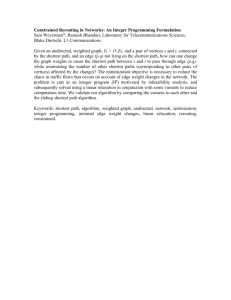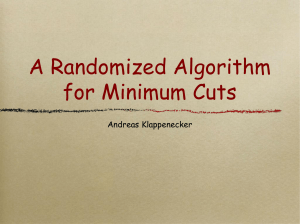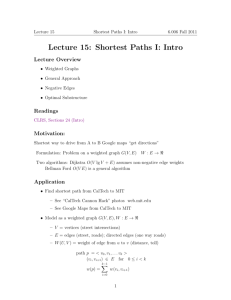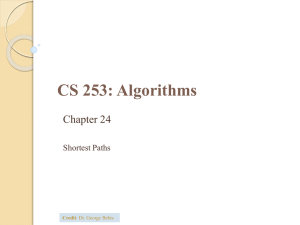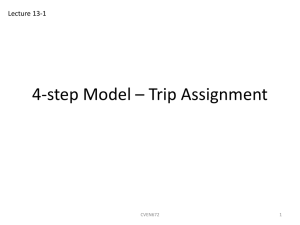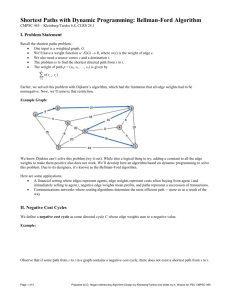SA10
advertisement
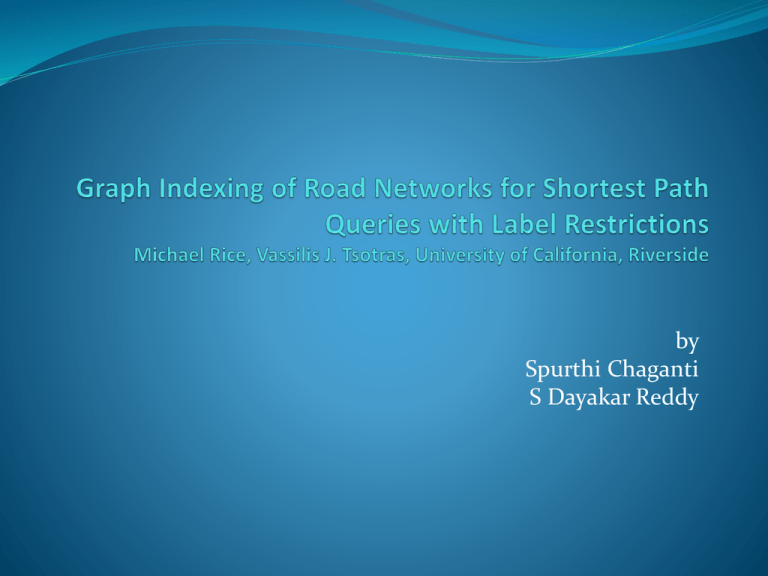
by
Spurthi Chaganti
S Dayakar Reddy
Problem Definition & Importance
Widespread usage of GPS Technologies and Maps Applications
No support of dynamic constraints in existing applications
Supporting Dynamic Constraints over large data sets
Enhancing the efficiency compared to the existing applications.
How to avoid toll gates, ferries while retrieving the shortest path?
Personalization and Logistics and Commercial Transportation
Why is the problem hard?
Supporting dynamic constraints involves either explicit re-computation
of the graph index online as the weights (or cost functions) of the edges
(roads) change or the query algorithm must make increasingly limited
use of the information available in the static graph index based on the
dynamic changes.
Proposed Approach
There are 2 concepts which are explained and used as the backbone in the
paper.
Kleene Language Constrained Shortest Path
Contraction Hierarchies with Label Restrictions
Kleene Language Constrained Shortest Path
Language Constrained Shortest Path (LCSP) is shortest path whose
edge labels must satisfy specified formal language constraint over a
fixed alphabet ∑.
Let G = (V, E,𝜔, ∑, l) be a directed graph, where V is the set of vertices in G, E is
the set of edges in G, 𝜔: E → R+ is a function mapping edges in G to a positive,
real-valued weight, ∑ is a finite alphabet used for labeling of edges in G, and l:
E->∑ is a function mapping edges in G to a label in ∑.
Let Ps,t = (e1, e2, · · · , ek) be any path in G from some vertex s ∈ V to some vertex
t ∈ V , such that e1 = (s, v1) ∈ E, ek = (vk−1, t) ∈ E, and for 1 < i < k, ei = (vi−1, vi) ∈
E. Let 𝜔(Ps, t) =Σ 1 ≤ I ≤ k 𝜔(ei) be the total weight of all edges in Ps,t.
Let l (Ps,t) = l (e1) l (e2) · · · l (ek) be the concatenation of the labels of all edges
in Ps,t. Given any formal language L ⊆ ∑*, a language constrained shortest path
is a path P’s,t in G such that l(P’s,t) ∈ L and ∀ Ps,t in G where l(P’s,t) ∈ L, 𝜔(P’s,t) ≤
𝜔(Ps,t).
CH graph indexing technique supports static point-to-point shortest
path queries very efficiently. The vertices in the graph G are given an
absolute ordering based on their importance which is defined through
the bijective function𝜙: V → {1, … ,|V |}). In the preprocessing stage, the
nodes (vertices) are contracted one at a time based on the importance
given by the bijective function 𝜙.
Kleene language is a Kleene closure of any subset of Σ i.e.,∀ A ∈ Σ, a Kleene
Language over alphabet A can be defined by L(A*). Alphabet A defines the set
of allowable labels that can appear on the shortest path in KLCSP problem.
Contraction Techniques
Witness Paths
Shortcut Edges
Bidirectional Dijkstras algorithm over upward and downward Edges
Limitations with CH when constraints are involved?
Authors Contributions
Contraction hierarchies with label restriction
Revised bidirectional dijkstras method
Multi edge support
Optimisations
Validation Methodology
The KLCSP and CHLR are constructed on already proven and existing
algorithms whose research work has already been published.
Also, the author gave mathematical proofs extending the already
existing proofs.
Along with theoretical proofs an experimental setup has been run on
the continent-wide graph dataset of North America (this includes only
the US and Canada), represented by a total of 21, 133, 774 nodes and 52,
523, 592 edges. 6, 779, 795 edges support one or more labels in this
dataset, with 0.21 labels per edge, on average.
Changes if I were to rewrite
Frequency of addition/deletion/modification of the constraints
Best path calculation instead of the shortest path.
Example: Travel b/n A and B, when time is the factor.
Traffic conditions inclusion in path calculation and prediction of traffic
condition.
Thank You
